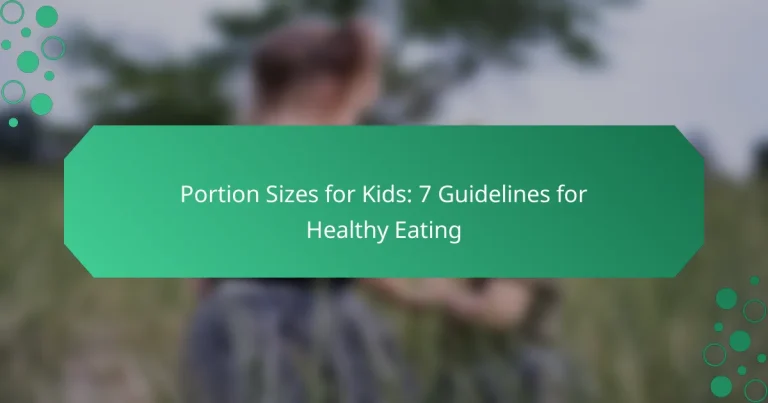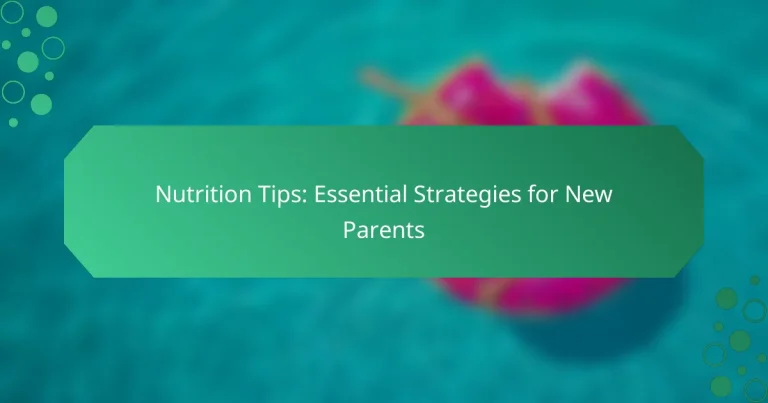Healthy Choices: Teaching Tips for Kids
Teaching kids about healthy choices is essential for fostering lifelong habits that promote well-being. By creating an engaging environment that emphasizes nutritious eating and active living, parents can effectively model and instill these values. Involving children in food preparation and utilizing fun activities like cooking classes and gardening can make learning about nutrition enjoyable and impactful.

How Can Parents Encourage Healthy Choices in Kids?
Parents can encourage healthy choices in kids by creating an environment that promotes nutritious eating and active living. This involves modeling behaviors, involving children in food preparation, and consistently offering healthy options.
Modeling healthy eating habits
Children often mimic the behaviors of adults, making it crucial for parents to model healthy eating habits. When kids see their parents choosing fruits, vegetables, and whole grains, they are more likely to adopt similar preferences. Aim to maintain a balanced diet yourself, showcasing a variety of healthy foods at every meal.
Additionally, discussing the benefits of healthy foods while eating can reinforce positive associations. For example, talking about how carrots help eyesight or how whole grains provide energy can make healthy choices more appealing.
Involving kids in meal preparation
Involving kids in meal preparation can foster a sense of ownership over their food choices. Allow them to help with simple tasks like washing vegetables, stirring ingredients, or setting the table. This engagement can spark their interest in trying new foods.
Consider planning meals together as a family. This not only teaches kids about nutrition but also encourages them to express their preferences, making them more likely to eat what they help prepare.
Setting regular meal times
Establishing regular meal times helps create a structured eating routine, which can promote better eating habits. Aim for three balanced meals a day, supplemented by healthy snacks. Consistency in timing can help regulate hunger cues and prevent overeating.
Try to sit down as a family for meals whenever possible. This not only encourages healthy eating but also provides an opportunity for family bonding and discussions about food choices.
Offering a variety of healthy foods
Offering a diverse range of healthy foods can help children develop a taste for different flavors and textures. Include fruits, vegetables, whole grains, and lean proteins in various forms to keep meals interesting. Aim for at least five different colors of fruits and vegetables each week.
Be patient with new foods; it may take several exposures before a child accepts a new item. Encourage them to try just a bite without pressure, making the experience positive and low-stress.
Using positive reinforcement
Positive reinforcement can be an effective strategy to encourage healthy choices in kids. Praise them when they make healthy food choices or try new foods, reinforcing their behavior. This could be verbal praise or small rewards like stickers or extra playtime.
However, avoid using food as a reward, as it can create unhealthy associations. Instead, focus on non-food rewards that celebrate their efforts and achievements in making healthy choices.

What Activities Promote Healthy Eating?
Activities that promote healthy eating engage children in hands-on experiences, making nutrition fun and educational. Cooking classes, gardening projects, and healthy cooking competitions are effective ways to instill healthy habits and knowledge about food.
Cooking classes for kids
Cooking classes for kids provide a practical way to learn about healthy eating. These classes can range from simple lessons on preparing fruits and vegetables to more complex recipes that incorporate whole grains and lean proteins.
When organizing cooking classes, consider age-appropriate tasks. Younger children can focus on washing and chopping, while older kids can learn to measure ingredients and follow recipes. Aim for classes that last about one to two hours to maintain engagement.
Gardening projects
Gardening projects allow children to connect with their food sources, fostering an appreciation for fresh produce. Kids can help plant, tend, and harvest fruits and vegetables, which enhances their understanding of where food comes from.
Start with easy-to-grow plants like tomatoes, carrots, or herbs. Even small container gardens can be effective, making it feasible for families with limited space. Encourage kids to taste their harvest, reinforcing the value of fresh, healthy foods.
Healthy cooking competitions
Healthy cooking competitions can motivate kids to explore nutritious ingredients creatively. By challenging them to prepare dishes using specific healthy items, you can spark their interest in cooking and nutrition.
Set clear guidelines for the competition, such as using whole foods and limiting processed ingredients. Consider organizing teams to promote collaboration and teamwork. Prizes can include cooking utensils or a family meal at a healthy restaurant, making the experience rewarding.

What Resources Are Available for Teaching Healthy Choices?
Various resources exist to help teach kids about healthy choices, including websites, cookbooks, and local workshops. These tools can provide valuable information and practical skills to encourage healthier eating habits among children.
Nutrition education websites
Nutrition education websites offer interactive content and resources tailored for children. Websites like ChooseMyPlate.gov provide age-appropriate information on food groups, portion sizes, and healthy eating habits.
Many of these sites include games, quizzes, and printable materials that make learning about nutrition engaging. Parents and educators can utilize these resources to create fun activities that reinforce healthy choices.
Children’s cookbooks
Children’s cookbooks are excellent tools for teaching kids how to prepare healthy meals. These cookbooks often feature simple recipes that use fresh ingredients, making cooking accessible and enjoyable for young chefs.
Look for cookbooks that emphasize nutrition and include sections on food safety and meal planning. Involving children in cooking can foster a positive relationship with food and encourage them to try new, healthy options.
Local health workshops
Local health workshops provide hands-on learning experiences about nutrition and healthy living. Community centers, schools, and health organizations often host workshops that teach children about food choices, cooking skills, and the importance of physical activity.
Check with local health departments or schools for upcoming workshops. Participating in these events can help reinforce lessons learned at home and provide children with practical skills to make healthier choices.

How Can Schools Support Healthy Choices?
Schools can play a crucial role in promoting healthy choices by implementing structured programs and providing nutritious options. By fostering an environment that prioritizes wellness, schools help students develop lifelong healthy habits.
Implementing nutrition programs
Nutrition programs in schools educate students about healthy eating habits and the importance of balanced diets. These programs can include interactive workshops, cooking classes, and nutrition education integrated into the curriculum.
Consider partnering with local health organizations to provide resources and expertise. Engaging students through hands-on activities can enhance their understanding and retention of nutritional concepts.
Offering healthy lunch options
Providing healthy lunch options is essential for supporting students’ dietary needs. Schools should aim to include a variety of fruits, vegetables, whole grains, and lean proteins in their menus while minimizing processed foods and sugary drinks.
Additionally, schools can offer salad bars or allow students to customize their meals. Regularly soliciting feedback from students and parents can help ensure the lunch options remain appealing and nutritious.
Creating a wellness committee
A wellness committee can oversee and promote health initiatives within the school. This group should consist of teachers, parents, students, and health professionals who collaborate to develop and implement wellness policies.
Establishing clear goals and regularly assessing progress can enhance the effectiveness of the committee. Consider organizing events such as health fairs or fitness challenges to engage the school community and raise awareness about healthy choices.

What Are the Benefits of Teaching Healthy Choices Early?
Teaching healthy choices to kids early in life fosters lifelong habits that contribute to overall well-being. Early education on nutrition and physical activity can lead to better health outcomes, improved learning, and enhanced social interactions.
Long-term health benefits
Instilling healthy choices from a young age can significantly reduce the risk of chronic diseases such as obesity, diabetes, and heart disease later in life. Children who learn about balanced diets and regular exercise are more likely to maintain these habits into adulthood.
Encouraging a variety of fruits, vegetables, and whole grains in children’s diets can lead to better nutritional intake. Parents can model healthy eating by preparing meals together and making nutritious snacks readily available.
Improved academic performance
Healthy choices can enhance cognitive function, leading to better academic performance. Studies suggest that children who eat well and stay active tend to have higher concentration levels and improved memory retention.
Incorporating physical activity into daily routines, such as walking or biking to school, can boost energy levels and focus in the classroom. Schools can support this by offering nutritious meals and snacks that fuel learning.
Enhanced social skills
Teaching kids about healthy choices can improve their social skills by encouraging teamwork and communication during group activities like cooking or sports. Participating in these activities helps children build friendships and learn to work collaboratively.
Additionally, discussing healthy choices can create opportunities for children to engage in conversations about nutrition and wellness with peers, fostering a supportive environment for shared learning. Parents can facilitate this by organizing group activities that focus on healthy eating or physical challenges.

What Challenges Do Parents Face in Teaching Healthy Choices?
Parents often encounter significant challenges when teaching their children about healthy choices. These obstacles can include time constraints, resistance from children, and a lack of resources or knowledge about nutrition.
Time constraints
Time constraints are a major hurdle for parents trying to instill healthy eating habits in their children. Busy schedules can make it difficult to plan and prepare nutritious meals, leading to reliance on fast food or processed options.
To combat this, parents can prioritize meal planning by dedicating a few hours each week to prepare healthy meals in advance. Batch cooking and freezing portions can save time during the week and ensure that nutritious options are readily available.
Additionally, involving children in meal preparation can be an effective way to teach them about healthy choices while spending quality time together. Simple tasks like washing vegetables or assembling salads can make the process enjoyable and educational.



